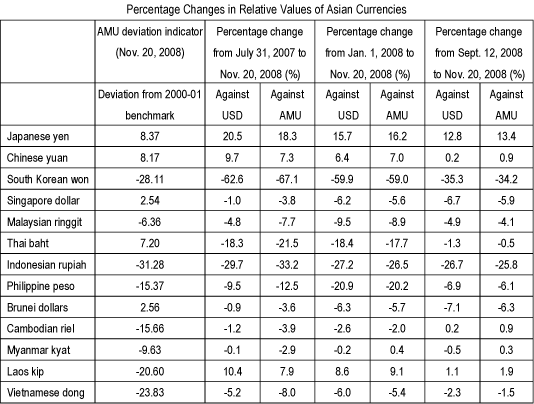The global financial crisis triggered by the subprime meltdown in the United States is impacting the foreign exchange market. Since Lehman Brother's Chapter 11 bankruptcy filing in mid-September, U.S. and European financial institutions have been facing difficulties in securing liquidity, forcing them to sell foreign currency denominated assets and repatriate the proceeds. These forced asset sales have resulted in steep declines in stock and other asset prices across Asia. Asian currencies have been depreciating sharply against the U.S. dollar as a result of the sell-off of local currencies accompanying the capital outflows. The only exception has been the Japanese yen, which has appreciated substantially against the U.S. dollar and other currencies as investors both in Japan and abroad unwind their yen-carry trades (borrowing in the yen at low interest rates and investing in assets denominated in higher-yielding currencies) and repay their yen loans.
The manifestation of crisis-related exchange rate patterns
As a result, foreign exchange rate movements have settled into a pattern in which the Japanese yen is the strongest, followed by the U.S. dollar and those currencies that are either explicitly or implicitly pegged to the U.S. dollar (i.e., the Hong Kong dollar, the Chinese yuan, and a handful of Middle Eastern currencies), further followed by the euro, and then by the currencies of smaller countries. Considering the fact that the financial crisis started in the U.S., it is quite ironic that the U.S. dollar has strengthened, albeit undeservedly, against all other currencies except the Japanese yen. This effect is attributable to the unique characteristics of the U.S. dollar as the key international currency. Because the U.S. dollar is the contractual currency in various financial transactions, banks have no choice but to maintain U.S. dollar reserves to secure liquidity.
Some Asian countries are concerned that the depreciation of their currencies relative to the U.S. dollar may lead to a currency crisis. To alleviate these concerns, it is important to measure currency values in terms of effective exchange rates. In cases where Asian currencies have been generally decreasing in value against the U.S. dollar, it is helpful to view this situation as an appreciation of the U.S. dollar and not an indication of capital flight from Asian countries. Yet because differences clearly exist among the rates of decline, it is necessary to pay due attention to any economy whose currency is experiencing a relatively deeper depreciation than those of its neighbors.
In this regard, it is useful to take a look at this year's movements of the AMU deviation indicators - which measure the degree to which each Asian currency deviates from a notional currency called the Asian Monetary Unit (AMU) - particularly since September (Figure: Nominal AMU Deviation Indicators*). Most Asian currencies have significantly declined in value relative to both the U.S. dollar and the AMU. Those that have declined in value relative to the AMU include the Indonesian rupiah, South Korean won, Malaysian ringgit, Philippine peso, Singapore dollar and Thai baht; whereas the Japanese yen and Chinese yuan have risen sharply.

Won depreciation, yen and yuan appreciation at the extreme ends of the spectrum
The South Korean won has depreciated more than any other Asian currency. It began appreciating in the second half of 2004 and was overvalued by as much as 20% relative to its benchmark exchange rate with the AMU from February 2006 to November 2007, but it has depreciated sharply since then. At the end of October 2008, the won was almost 30% undervalued relative to the benchmark, indicating that its value has halved over the past year. Although to a lesser extent, other Asian currencies, particularly the Thai baht, have also lost value due to the subprime crisis and fallout from Lehman Brothers' demise.
Unlike the South Korean won and Thai baht, both the Japanese yen and Chinese yuan have increased in value relative to the overall value of Asian currencies. The Japanese yen, which was undervalued by about 14% relative to its AMU benchmark exchange rate in July 2007, has since been on an upward trend and reached a level 7% above the benchmark by the end of November 2008. During the past year, the yen has appreciated more than 20% relative to the overall value of Asian currencies. Meanwhile, the Chinese yuan, which had previously been neither undervalued nor overvalued, began appreciating in March 2008. As of the end of November 2008, the yuan was relatively overvalued by about 8% as other Asian currencies were in decline.
Currencies should be measured in terms of effective exchange rates
Turmoil in the U.S. financial markets is expected to continue causing enormous capital flows and have a significant impact on certain foreign exchange rates in the coming months. Asian countries, where the direct impact of the subprime crisis was relatively small, have begun experiencing significant subprime fallout with their domestic economies affected by declining exports to the U.S. (export channel), falling stock prices (capital flow channel) and so forth. Sudden changes in capital flows caused by the financial crisis can have a great effect on foreign exchange rates. Thus, it is necessary to keep a close eye on foreign exchange rate movements. And what must be kept in mind are currency measurements in terms of effective exchange rates, rather than focusing solely on their nominal values relative to the U.S. dollar. In this respect, the AMU deviation indicators, which show each currency's relative value in Asia, play a very important role.


